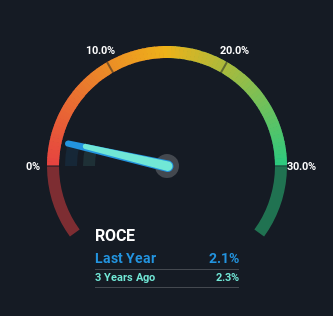Returns On Capital Signal Tricky Times Ahead For Toyota Industries (TSE:6201)

What are the early trends we should look for to identify a stock that could multiply in value over the long term? In a perfect world, we'd like to see a company investing more capital into its business and ideally the returns earned from that capital are also increasing. If you see this, it typically means it's a company with a great business model and plenty of profitable reinvestment opportunities. Having said that, from a first glance at Toyota Industries (TSE:6201) we aren't jumping out of our chairs at how returns are trending, but let's have a deeper look.
Understanding Return On Capital Employed (ROCE)
For those that aren't sure what ROCE is, it measures the amount of pre-tax profits a company can generate from the capital employed in its business. The formula for this calculation on Toyota Industries is:
Return on Capital Employed = Earnings Before Interest and Tax (EBIT) ÷ (Total Assets - Current Liabilities)
0.021 = JP¥200b ÷ (JP¥11t - JP¥1.6t) (Based on the trailing twelve months to March 2024).
Thus, Toyota Industries has an ROCE of 2.1%. In absolute terms, that's a low return and it also under-performs the Machinery industry average of 8.0%.
Check out our latest analysis for Toyota Industries

Above you can see how the current ROCE for Toyota Industries compares to its prior returns on capital, but there's only so much you can tell from the past. If you'd like to see what analysts are forecasting going forward, you should check out our free analyst report for Toyota Industries .
What The Trend Of ROCE Can Tell Us
On the surface, the trend of ROCE at Toyota Industries doesn't inspire confidence. Over the last five years, returns on capital have decreased to 2.1% from 3.1% five years ago. Although, given both revenue and the amount of assets employed in the business have increased, it could suggest the company is investing in growth, and the extra capital has led to a short-term reduction in ROCE. And if the increased capital generates additional returns, the business, and thus shareholders, will benefit in the long run.
The Bottom Line
In summary, despite lower returns in the short term, we're encouraged to see that Toyota Industries is reinvesting for growth and has higher sales as a result. And long term investors must be optimistic going forward because the stock has returned a huge 163% to shareholders in the last five years. So should these growth trends continue, we'd be optimistic on the stock going forward.
Toyota Industries does have some risks though, and we've spotted 1 warning sign for Toyota Industries that you might be interested in.
While Toyota Industries isn't earning the highest return, check out this free list of companies that are earning high returns on equity with solid balance sheets.
Valuation is complex, but we're here to simplify it.
Discover if Toyota Industries might be undervalued or overvalued with our detailed analysis, featuring fair value estimates, potential risks, dividends, insider trades, and its financial condition.
Access Free AnalysisHave feedback on this article? Concerned about the content? Get in touch with us directly. Alternatively, email editorial-team (at) simplywallst.com.
This article by Simply Wall St is general in nature. We provide commentary based on historical data and analyst forecasts only using an unbiased methodology and our articles are not intended to be financial advice. It does not constitute a recommendation to buy or sell any stock, and does not take account of your objectives, or your financial situation. We aim to bring you long-term focused analysis driven by fundamental data. Note that our analysis may not factor in the latest price-sensitive company announcements or qualitative material. Simply Wall St has no position in any stocks mentioned.
About TSE:6201
Toyota Industries
Manufactures and sells textiles machinery, materials handling equipment, automobiles, and automobile parts in Japan, the United States, and internationally.
Solid track record with excellent balance sheet.
Similar Companies
Market Insights
Community Narratives



